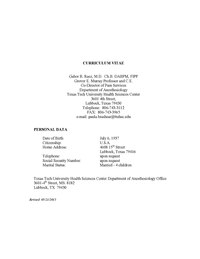Curriculum vitae

In English, a curriculum vitae (English: / ... ˈviːtaɪ, -ˈwiːtaɪ, -ˈvaɪtiː/),[1][2][3][4] Latin for "course of life", often shortened to CV, is a short written summary of a person's career, qualifications, and education. This use of the term for such a short summary is the most common usage in both North American and British English.[2][4] In North America but not elsewhere, the term résumé is a common synonym for CV in this sense of short career summary.[5][6]
The term curriculum vitae (and its abbreviation CV) is also used especially in academia to refer to very extensive or even complete summaries of a person's career, qualifications, and education including publications and other information. This has caused the widespread misconception that it is incorrect to refer to short CVs as CVs in American English and that short CVs should be called résumés, but this is not supported by the usage recorded in American dictionaries. For example, the University of California, Davis specifically points out that "[i]n the United States and Canada, CV and resume are sometimes used interchangeably" while describing the common distinction made in North American academia between the use of these terms to refer to documents with different contents and lengths.[7]
In many countries, a short CV is typically the first information that a potential employer receives from a job seeker and is typically used to screen applicants, often followed by an interview. CVs may also be requested for applicants to postsecondary programs, scholarships, grants, and bursaries. In the 2010s it became popular for applicants to provide an electronic version of their CV to employers using email, an online employment website, or a job-oriented social-networking-service website, for example LinkedIn.
Contents[]
This section needs additional citations for verification. (February 2015) |
General usage[]
In general usage in all English-speaking countries, a CV is short (usually a maximum of two sides of A4 paper),[2][4] and therefore contains only a summary of the job seeker's employment history, qualifications, education, and some personal information. Such a short CV is often also called a résumé only in North America, where it is however also often called a CV outside academia.[5][6] Some parts of Asia require applicants' photos, date of birth, and most recent salary information. CVs are often tailored to change the emphasis of the information according to the particular position for which the job seeker is applying. A CV can also be extended to include an extra page for the jobseeker's publications if these are important for the job.
In academia[]
In academic and medical careers, a CV is usually a comprehensive document that provides extensive information on education, publications, and other achievements. Such a CV is generally used when applying for a position in academia, while shorter CVs (also called résumés in North America) are generally used when applying for a position in industry, non-profit organizations, and the public sector.[7]
Etymology, spelling, and plural[]
Curriculum vitae can be loosely translated as [the] course of [one's] life. It is a loanword from New Latin, which is why it was traditionally spelled curriculum vitæ using the ligature æ also in English,[8] but this is now rare.
In English, the plural of curriculum alone is often curriculums instead of the traditional Latin plural curricula, which is why both forms are recorded in English dictionaries. The English plural of curriculum vitae is however almost always curricula vitae as in Latin, and this is the only form recorded in the Merriam-Webster, American Heritage, and Oxford English dictionaries, for example.[2][3][4] (The very rare claim that the Latin plural should be curricula vitarum is in fact an incorrect hypercorrection based on superficial knowledge of Latin.)[9]
See also[]
- Applicant tracking system
- Background check
- Cover letter
- Europass – European Standardised model
- Human resources
- Résumé fraud
- Video résumé
References[]
- ^ In English, the first part is always pronounced like when this common English word is used alone, never as in Latin (even by people who know Latin well), but vitae is pronounced in various ways depending on how much the speaker knows about Latin. The Classical Latin pronunciation was [ˈwiː.tae̯], but even most people who learned Latin in school are unaware of the linguistically reconstructed correct pronunciation of Latin. Instead, they use the pronunciation /ˈviːtaɪ/, which is the pronunciation of Latin commonly taught in school in the past, or /ˈwiːtaɪ/, the one increasingly taught today. Most people nowadays never have any Latin in school, and many of them use the pronunciation /ˈvaɪtiː/.
- ^ Jump up to: a b c d "Curriculum Vitae | Definition of Curriculum Vitae by Merriam-Webster". merriam-webster.com. Retrieved 27 June 2016.
- ^ Jump up to: a b "American Heritage Dictionary Entry: curriculum vitae". ahdictionary.com. Retrieved 27 June 2016.
- ^ Jump up to: a b c d Definition of "curriculum vitae" by Oxford Dictionary on Lexico.com
- ^ Jump up to: a b Definition of "résumé" by Merriam-Webster
- ^ Jump up to: a b Definition of "résumé" by Oxford Dictionary on Lexico.com
- ^ Jump up to: a b "Resume vs. Curriculum Vitae: What's the Difference? | Internship and Career Center". icc.ucdavis.edu. Retrieved 27 June 2016.
- ^ List of words that may be spelled with a ligature
- ^ "alt.usage.english FAQ". Archived from the original on 3 April 2012. Retrieved 2 June 2012.
External links[]
| Look up curriculum vitae in Wiktionary, the free dictionary. |
| Wikimedia Commons has media related to Curricula Vitae. |
- CV guide – Massachusetts Institute of Technology – Global Education & Career Development, United States
- Cover Letter guide – Massachusetts Institute of Technology – Global Education & Career Development, United States
- Recruitment
- Business documents
- Latin words and phrases